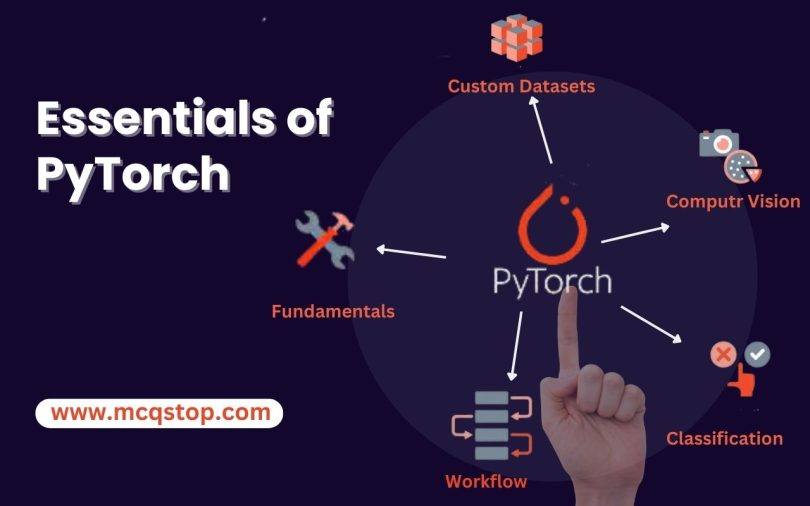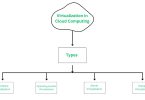What is PyTorch?
PyTorch is a complete framework for developing deep learning models. Its models are widely utilized in categorization assignments like image identification and language comprehension. Many machine learning developers have access to its Python implementation and thus to the language. It is worth mentioning that the essentials of PyTorch with Python can support GPUs and uses reverse-mode auto-differentiation enabling the modification of the computation graph at the runtime mode. Because of this aspect, PyTorch serves as the most favored choice for rapid experiments and prototype developments.
Rationale behind PyTorch:
The contributors to Facebook AI research and other research labs developed PyTorch that combines the fast GPU-accelerated backend libraries of Torch with a Python frontend. Routing in this front end highlights quick prototyping, code readability and support for many deep learning types. Developers are able to implement an imperative programming model with smooth graph production through PyTorch. PyTorch has been an open source since 2017 with its Python-based approach gaining a lot of favor with machine learning developers.
Unlike other debuggers, PyTorch makes use of Chenier’s reverse-mode AD as a tape recorder which rewinds operations in order to compute the gradients. It is ideal for dynamic neural networks and thus a key feature for prototyping, where every iteration is different.
The framework’s appeal to Python developers is its alignment with Python’s imperative, define-by-run execution model. PyTorch’s adoption by python developers, particularly those new to DL, is supported by a survey reflecting the increasing spotlight on AI and ML tasks within the python community. Its consistency from the first versions makes it available even for old-school python developers.
PyTorch’s Strengths:
It is more effective for quick prototyping and small projects. It has been a favorite among users in research and academia because of its user-friendly interface and flexibility.
Ongoing Developments:
Improvements such as the addition of the ability to run on a just-in-time basis as well as support for Tensor board have made recent facebook releases in PyTorch a very useful tool for developers. Also, PyTorch has broadened its interoperability with ONNX (Open Neural Network Exchange). It allows programmers to use the different deep learning frameworks and runtimes suited to their needs in particular applications.
Fundamentals of PyTorch:
Just like in NumPy, basic operations in PyTorch are almost similar. To understand these basics includes knowing about tensors that represent numbers used for data processing in machine learning.
In mathematical terms, tensors are the basic unit of data which can accommodate different dimensions and types with PyTorch setting it as the 32-bit float tensor by default. Likewise, PyTorch mathematical operations resemble their equivalents used in NumPy, so that one has to initialize tensors before operations like addition, subtraction, multiplying or dividing.
PyTorch Modules:
PyTorch modules represent neural networks. One key module is autograd which is a Python toolkit for automatic differentiation that builds directed acyclic graphs to enhance efficiency in computing gradients.
There is an Optim module which includes ready-made algorithms for essential optimizers used while developing neural networks.
The nn module has several sets of classes for constructing neural network model and all modules in PyTorch inherit from the “nn” module.
How PyTorch Operates?
Similarly, as a Python-centric programming platform, PyTorch follows a Pythonic style of coding, making use of all the peculiarities of the language so as to produce readable code. The fact that it is compatible with python dynamic computation graphs enables DEVs, scientists as well as neural net buggers in running as well as testing pieces of code directly without having to have a program finalized.
Key Features of PyTorch:
Tensor Computation:
Like NumPy arrays, PyTorch tensors are generalized n-dimensional arrays allowing for arbitrary numeric computation and speed by using GPUs.
Application program interfaces (APIs) allow them to manipulate these multi-dimensional structures.
TorchScript:
It is PyTorch’s production environment so that it can smoothly switch between modes.
The focus is on performance, ease of operation, user-friendliness and flexibility.
Dynamic Graph Computation:
It enables users to amend network behavior on the fly without executing all of the code.
Automatic Differentiation:
Backward passes in neural networks are used for approximating function derivatives through numerical calculations.
Python Support:
Because it is based on python, it connects easily with popular libraries and packages like Numpy, SciPy, Numba and Cython.
Variable:
A point within a computational graph, containing the gradient outside the tensor.
Parameter:
A variable is wrapped in parameters and used when a parameter must be treated as a tensor, which is not possible otherwise.
Module:
States are realized via cells, which represent neural networks in a way.
Modules can have other modules and parameters.
Functions:
Define relationships between two variables.
Functions have no memory to store state or buffers and are not persistent themselves.
Benefits of Using PyTorch:
- It is a straightforward model that provides simple coding structures built on Python.
- Can be easily debugged using popular Python tools.
- Offers scale-out architecture and resilient support on leading cloud providers.
- Open source-based small community centric.
- Export of the learning models to the ONNX standard format.
- Provides an intuitive UI, as well as a choice of C++ front-end.
- Extends PyTorch library with a diverse suite of versatile APIs.
PyTorch vs. TensorFlow:
- PyTorch is compared with Google’s deep machine learning framework called TensorFlow.
- Unlike TensorFlow whose computational graph is set, PyTorch has a dynamic graph that can be modified in real time.
- TensorFlow is best for production model scalability compared to projects but a light version of PyTorch is fitter for quick prototyping and research needs.
Top PyTorch Use Cases:
PyTorch has been found to be employed in most fields such as NLP and picture identification.
It enhances the comprehension of human language in Natural Language Processing (NLP) using sophisticated NLP language models such as Salesforce developed in 2018, which performs more than 10 tasks at an instant.
Reinforcement Learning with Pyqlearning:
Reinforcement learning is a kind of machine learning implemented using Pyqlearning, the python library. Machines develop RL capability to allow them to gain experience so that they can make decisions that yield positive results. Robot Motion Control and Business Strategy Planning are the main applications of RL; it uses Python Deep Q Networks to build models.
Image Classification Using PyTorch:
Algorithms for image classification allow for classifying an image according to its content. They include such algorithms for instance that can tell whether the image showcases a cat or a dog. In our daily lives, we have evolved to detect some of the objects in our environment which computers find difficult. One of the things that make PyTorch unique is its ability to process images and videos allowing developers to develop efficient computer vision models.
NLP and PyTorch:
Natural Language Processing (NLP) has been growing fast in recent years due to the language models ability to quickly understand human language using unsupervised training on large text corpora. NLP’s major player is PyTorch. The benefit of a chatbot through NLP is a way to improve the performance using better NLP, such as intent and sentiment analysis.
Summary:
In summary, PyTorch is a powerful framework for deep learning, widely embraced for its Pythonic nature, GPU support and dynamic computation graph. Originating from Facebook AI Research, its strengths lie in rapid prototyping, flexibility and consistent Python-based development since its open-source debut in 2017. Recent enhancements, including just-in-time execution and ONNX support, underscore its relevance in the evolving landscape. With fundamental operations akin to NumPy, essential modules, and a Python-friendly approach, PyTorch remains a top choice for diverse machine learning (ML) applications.






Leave a Comment